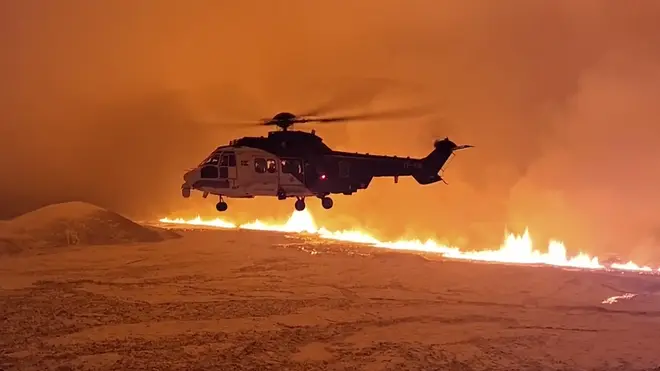
Matt Frei 10am - 12pm
19 December 2023, 18:54

As the eruption spread, magma, or semi-molten rock, could be seen spewing along the ridge of a hill.
A volcano has erupted in southwestern Iceland, spewing semi-molten rock into the air in a spectacular show of Earth’s power in the land known for fire and ice.
The eruption, which began on Monday night, happened about 2.4 miles from the town of Grindavik, the Icelandic Meteorological Office said.
The town near Iceland’s main airport was evacuated in November after thousands of earthquakes damaged homes and raised fears of an imminent eruption.
On Tuesday, fountains of orange lava shot into the darkened sky from a fissure in the ground.
Iceland, which sits above a volcanic hot spot in the North Atlantic, averages an eruption every four to five years.
The most disruptive in recent times was the 2010 eruption of the Eyjafjallajokull volcano, which spewed huge clouds of ash into the atmosphere and led to widespread airspace closures over Europe.
But the eruption on the Reykjanes Peninsula, about 31 miles southwest of the capital, Reykjavik, is not expected to release large amounts of ash into the air.
Iceland’s foreign minister, Bjarne Benediktsson, tweeted that there were no disruptions of flights to and from the country and international flight corridors remain open.
Icelandic broadcaster RUV showed a live feed of the eruption on its website. Christmas carols played in the background.
By early afternoon on Tuesday, the Icelandic Meteorological Office reported that the size of the volcanic eruption “continues to diminish”.
It said the lava flow was estimated to be a quarter of what it was at the time of the eruption. Lava “fountains”, which reached as high as 30 metres have also been falling.
The November evacuation of Grindavik meant few people were near the site of eruption when it occurred, and authorities have warned others to stay away.
The nearby Blue Lagoon geothermal spa — one of Iceland’s biggest tourist attractions — also closed temporarily that month as a swarm of earthquakes put the island nation on alert for a possible volcanic eruption.
So far, the town and its vital power plant are safe.

Prime Minister Katrin Jakobsdottir told RUV that for now, the lava was not endangering critical infrastructure near the volcano. Although the lava flow was moving in a promising direction, precautions were nevertheless being taken near the Svartsengi power plant.
“We also know that the flow of lava can change the surrounding landscape, so this can change with short notice, Ms Jakobsdottir said.
Nonetheless, the residents of the evacuated fishing community of 3,400 had mixed emotions as they watched the orange flames touch the dark skies.
One month after the evacuation, many are still living in temporary accommodation and do not expect to ever be able to return to live in their homes.
“The town involved might end up under the lava,” said Ael Kermarec, a French tour guide living in Iceland.
“It’s amazing to see but there’s kind of a bittersweet feeling at the moment.”
Magnus Tumi Gudmundsson, a scientist who flew over the site on Tuesday morning on a coastguard research flight, told RUV that he estimates twice as much lava had already spewed than the entire month-long eruption on the peninsula this summer.

Mr Gudmundsson said the eruption is expected to continue decreasing in intensity but scientists have no idea how long it could last.
“It can be over in a week or it could take quite a bit longer,” he said.
Matthew Watson, a professor of volcanoes and climate at the University of Bristol, said tourists should strictly follow advice because significant hazards, such as new breakouts, can quickly put people in harm’s way.

“As is common with this eruptive style, it began with a sustained eruption of ballistics that, over time, has lengthened to form a fire curtain — a long fissure out of which lava is being violently ejected,” he said.
“This style of eruption is amongst the most spectacular ever seen and there will be a strong pull for tourists, even though the Blue Lagoon complex has again shut.”

The spectacular natural phenomenon is already proving hard for people to resist.
“It’s just something from a movie,” said Robert Donald Forrester, a tourist from the United States.